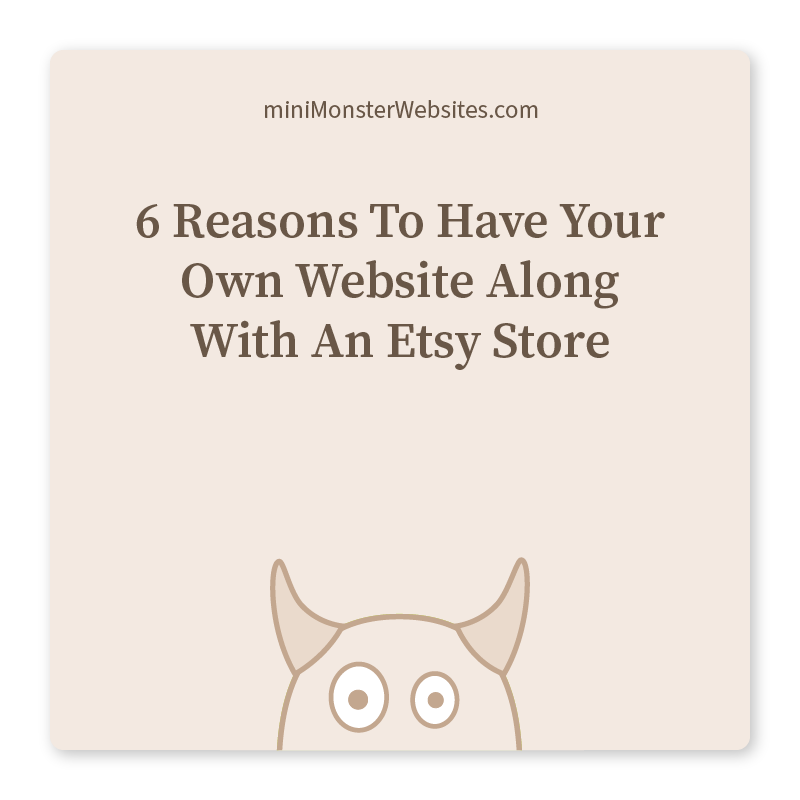6 Reasons To Have Your Own Website Along With An Etsy Store
If you are a small maker and creator, it may seem as though the obvious choice for you is to set up an Etsy store, sell your wares from there, and ride off into the sunset. We are huge fans of Etsy ourselves. It is a great marketplace for attracting an audience because of its enormous popularity and huge number of users. Having access to all those eyeballs can be invaluable when starting your business.
We are not suggesting that you move your store off Etsy. You don’t want to give up those views, and it’s a great way for people to find you. But after you have set up your Etsy store, you should have a next step in mind for your company.
Ultimately, you want to use Etsy as a springboard for your business instead of the final destination. So, here are the biggest reasons to consider creating your own website in addition to an Etsy store.
Reason #1 - Etsy Fees
It’s no wonder that Etsy has become the default place for small makers to sell. It is wonderfully, ridiculously affordable to get started. You don’t need to make a huge investment to open up a store. A basic account to sell on Etsy comes without a monthly fee. As in, free. As in, no startup costs at all to open your store. When you put something up for sale, Etsy charges a $0.20 listing fee for each item, which is a reasonable cost for all of the potential customer exposure.
Once you make a sale, you pay a percentage of your sales revenue to Etsy. This transaction fee charged is 5% of your item’s total price. In the US, the total price includes shipping and gift wrapping*. If you include tax into the price you are charging for an item, then the tax will also be included in the total cost to figure Etsy’s transaction fee.
Let’s look at an example. If you have an item that you are selling for ten dollars, with two dollars worth of gift wrap and five dollars shipping:
$ 10.00 item
$ 2.00 gift wrap
$ 0.84 tax (7%)
$ 5.00 shipping =
_______________
$17.84 total price to buyer
Your Etsy transaction fee charged would be 5% of that cost, or $0.89. When we add in the $0.20 listing fee, Etsy is getting a total of $1.09. That doesn’t seem so bad.
On top of the Etsy fee, you will also be charged 3% - 4% of the total for credit card processing fees. A 4% fee would be $0.71. If we add that to the $1.09 Etsy is charging:
Total selling fees: $1.80, or 18% the original price of your item.
Again, this doesn’t seem all that bad. But the idea is to grow your business, so let’s think about bigger numbers. If you sell $10,000 of product, it is going to sting a little bit more to pay out $1,800 in fees. Eventually you are going to want customers to go straight to your website when they are shopping. You’re still going to have to cough up those credit card fees, that’s just part of life. But savings is savings. Definitely worth thinking about.
*As of this writing, gift wrapping is taxable in 17 states.
Reason #2 - Etsy’s purpose is to sell things, but not necessarily your things
Sure, there may be 80 million people buying stuff on Etsy, but sometimes it feels like there are also 80 million people selling there, too. Remember that it is Etsy’s job to sell things to people, but they don’t really care whose things they sell. They simply need to make sure that a customer finds what they want. So, it is in Etsy’s best interests to give the customer as many choices as they can to ensure a sale.
One of the ways Etsy provides more options for its customers is to actively advertise items similar to yours at the bottom of your listing page, giving you competition even after someone has clicked on your item to see the details. Some of these recommendations are paid ads from other sellers, which is another revenue stream for Etsy.
Keep in mind that although you are working with Etsy, Etsy isn’t working directly for you. They control the traffic on their website.
On your own website, your work will be surrounded by, well, more of your work. The necklace that you created and poured your soul into will be surrounded by other pieces that you created. If the web viewer gets distracted by another piece of jewelry and dives down a different rabbit hole, they are still looking at your work. Your website, your rabbit holes, your work. You won’t be losing your audience to anyone else.
Reason #3 - You want to build your own brand story
While Etsy is great at providing lots of potential customers for that new item you just added to your store, it doesn’t allow you to really customize your storefront, so it’s not the best for building your relationships with customers or allowing you to tell your story.
Building your own brand and audience is critical to your long-term success. That’s just easier to do on your own website. You can take the time to explain who you are, why you do what you do, and what makes your work special and worth the investment. You can use the site to create interesting content that will keep customers coming back to see what you are up to. These could be weekly blog posts to let people know what you are working on, or videos showing you in the process of creation. By engaging your customers, you create an intimacy with them and add value to your work.
Let’s say you are a furniture maker and just completed the coolest coffee table that humankind has ever seen. You’re selling it for $3,500. Where is it going to be easier to justify that cost? On your own website, you can tell the story of that table, complete with the idea that started it all, photos, detailed descriptions of the materials and techniques used, daily progress updates, and videos. On Etsy, your first chance to capture an audience is a 2 x 3 inch thumbnail image next to a photo of a $50 particle board table straight from the 1970s.
Use your own website to create an experience for the customer that reinforces who you are and what your work is about. This is how you turn casual one-time customers into fans and, more importantly, repeat customers.
Reason #4 - You want more subscribers for your mailing list. (You do have a mailing list, right?)
It sounds old fashioned, but email is still pretty great way to communicate and build a relationship with your audience, and keep top-of-mind awareness. Whether it is by making sure everyone is up to date with all the fabulous work you are producing, or letting them know about upcoming shows where they could see you and your work in person, email is an easy way to make a connection with a lot of people.
Etsy makes it pretty clear that you are not allowed to use a customer’s email address that you collected during a sale for anything except communication about that sale. So, even with a ready-made mailing list of past customers, you aren’t allowed to directly advertise or market to them. And, with online privacy laws strengthening, we also need to start considering the situation from the customer’s point of view: they didn’t actually ask us to email them anything else.
When you have your own website, letting people sign up for emails from you is a breeze. First off, visitors to your website will actively opt-in to a mailing list. These subscribers have shown an active interest in you and your work, and are telling you that they want to hear from you. Reach out from time to time and keep them in the loop! Best of all, you own the email list, not Etsy.
Are you on a couple of social media platforms as well? Great! Let your website viewers know where else they can find you. Now they are engaging with you on multiple channels. You’re getting a fan club going!
Reason #5 - You want to sell products that don’t fit within Etsy’s guidelines
Settle down, you rowdy kids in the back!
We think that everyone can get on board with not selling illegal drugs and bombs online. And, of course, we all realize that Etsy is aiming for, if not family-friendly, then at least a PG-13 rating. Of course Etsy is going to need to establish policies about what is appropriate to sell on their site.
They broadly describe items that are prohibited as anything that is:
- Legal risk to our community
- Inconsistent with our values
- Harmful to our members
- Not in the spirit of Etsy
Yes, those are very vague, general descriptions. And, they are completely up to Etsy to interpret. Etsy’s policy makes it very clear that if they deem an item that you are selling inappropriate by any of these standards, they can remove the item or terminate your account.
Specific categories of items are also listed as prohibited, and those are also subject to Etsy’s interpretation.
One of Etsy’s prohibited categories is violent items, defined as items that “promote, support, or glorify violence.” Does your cross-stitched art depicting the Hulk throwing Loki around like a ragdoll count as violent? Would the caption ‘puny god’ that you added at the bottom be deemed inconsistent with the values of Etsy? We can’t tell you for certain, because it is up to Etsy to decide.
Reason #6 - You don’t want your entire income stream to be controlled by Etsy
Much like the previous reason, the hard truth is that you have no say over what happens on Etsy. That marketplace is outside of your control. Their house, their rules.
Let’s say you have invested enormous time and effort into your Etsy store. You’re doing well with it and you have made it your full-time job. It’s paying the bills and you are living the dream. What happens if Etsy pulls the plug on your store for some reason? Your only source of income could be gone in a single day. You could protest and make your case to the powers that be at Etsy, but even if you win, how long will it take? How many months could you manage without income?
Now, we genuinely are not trying to fear monger. Is Etsy likely to close your store? No.
But, if you asked me a few years ago if a pandemic would keep people inside for two years and reshape the way the world does business, I probably would have given you a hard no on that, too.
We live and learn. Maybe the best lesson that any business could get out of the COVID era is to be aware of what you do control and what you don’t. If you can control the platform that brings in your sales and income, it’s probably a good idea. There are enough things in the universe that we don’t have any say in. Don’t risk what you don’t have to is a pretty solid business model.
Start telling your story and building your own audience outside of Etsy. Own your own customer information. Control what you can in your own business. Don’t let yourself be at the mercy of a single platform when you don’t have to.
Check out our Artisan Template with its own online shop. It is the perfect next step to take after Etsy!







